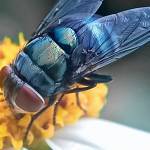Screwworm in Horses: Surveillance and Reporting Imperative

Entomologists and government officials are on high alert for the reappearance of an insidious pest, one in which the United States has not battled in nearly 20 years: the New World screwworm (NWS, Cochliomyia hominivorax).
While humans can be infected, the NWS typically targets wildlife, pets, and livestock, including horses. Economic losses can be enormous, especially for cattle producers, often causing millions of dollars in lost revenue.* Aside from health issues, the presence of NWS can cause problems for horse owners, including the potential for transport restrictions, which could hamstring normal activities within the industry, including shows, sales, and breeding endeavors.
Native to Central and South America, NWS first appeared in the United States in the 1800s. Due to eradication efforts from several national governments, including the United States, NWS has not been identified in the United States in a widespread way for decades. In 2016, an isolated outbreak occurred in southern Florida, primarily affecting Key deer residing on a 9,200-acre federal refuge.+
In November 2024, however, a cow in southern Mexico was identified with NWS and that, according to officials, is concerning because it proves NSW is moving northward. In fact, this discovery prompted the United States Department of Agriculture to ban cattle imports from Mexico.++
Life cycle. Female NWS flies lay eggs, typically hundreds at a time, primarily in open wounds of warm-blooded animals, but they will also occasionally deposit eggs on mucous membranes.
Almost all wounds are fair game as potential egg-laying sites, including minor lacerations caused by the roughhousing of young horses; typical bite and kick abrasions resulting from pecking-order disputes; deep rubs caused by sheets, blankets, grazing muzzles, bits, or halters; castration incisions; and broken skin characteristic of scratches, summer sores, or severe rainrot.
Vulnerable wounds can be surprisingly minuscule, according to researchers, with even a tick bite sufficiently tempting for a screwworm to lay eggs.
Eggs hatch on the surface of the wound and then immediately burrow into the flesh, on which they feed. Deep burrowing is a distinctive feature of screwworms, as larvae of other fly species are surface feeders, typically devouring dead tissue. After about a week of feeding, larvae drop to the ground, drill into the soil, pupate, and emerge as flies in as little as three days. Adult flies are slightly larger than common houseflies and are identified by orange eyes, metallic blue or green body, and dark stripes down the back.
Clinical signs. Wounds infected with screwworms refuse to heal, often becoming larger in area as larvae dig deeper for fresher flesh. The wounds and drainage from them are stereotypically foul-smelling. Depending on the site of the wound as well as the overall health of the animal, death may occur from secondary infection a week to two weeks after infestation if not treated.
Reporting. As a foreign animal disease, a state or federal animal health official must be notified of suspected cases. Veterinarians have this obligation, so work closely with your vet if you suspect NWS infestation. If NWS is diagnosed, quarantine will be imposed on the animal and potentially the premises.
Treatment. Daily wound care is imperative with removal and disposal of all visible larvae. Treatments with larvicides and insecticides have successfully eliminated larvae. Other supportive care may be necessary. Rely on a veterinarian’s recommendations for best treatment options. A healthy horse on a sound nutrition program has the best chance of healing well. Targeted nutrition that includes natural-source vitamin E and omega-3 long-chain polyunsaturated fatty acids promote optimal recovery on the cellular level.
Protecting horses. Everyday handling of horses is the first step in recognizing a potential NWS infestation. Thoroughly inspecting horses daily for wounds and treating wounds promptly and appropriately can stave off potential problems. While bandaging is often not feasible with some wounds, other barriers can be used to keep sores or lesions free of flies, including the use of well-fitting fly sheets and boots; ointments, salves, and other medications; and high-powered fans.
Horses entering the United States from a country with a known NWS problem may be required to be pretreated with an ivermectin product, remain in a quarantine facility for a week, and pass a thorough physical examination to rule out NWS.
*Bittle, J. 2019. Why the government breeds and releases billions of flies a year. National Geographic. Dec. 11. Accessed January 14, 2025.
+Robles, F. 2016. A long-gone parasite returns to Florida, leaving a trail of dead deer. The New York Times. Nov. 25. Accessed January 14, 2025.
++Salhotra, P. 2025. Mexican cattle banned from Texas due to screwworm threat. The Texas Tribune. January 13.
Other references:
Masterangelo, T., and J.B. Welch. 2012. An overview of the components of AW-IPM campaigns against the New World screwworm. Insects 3:930-955.
Scott, M.J., C. Concha, J.B. Welch, P.L. Phillips, and S.R. Skoda. 2017. Review of research advances in the screwworm eradication program over the past 25 years. Entomologica Experimentalis et Applicata 164:226-236.








